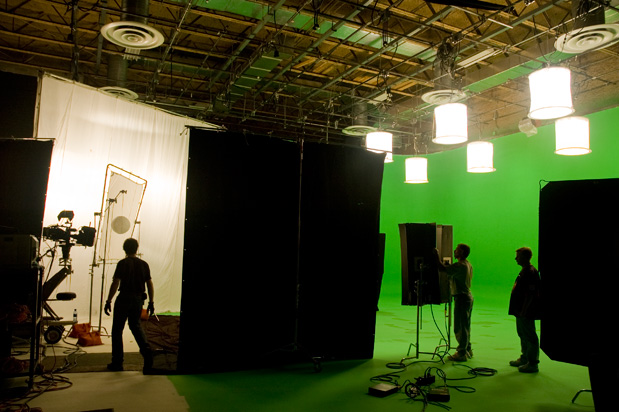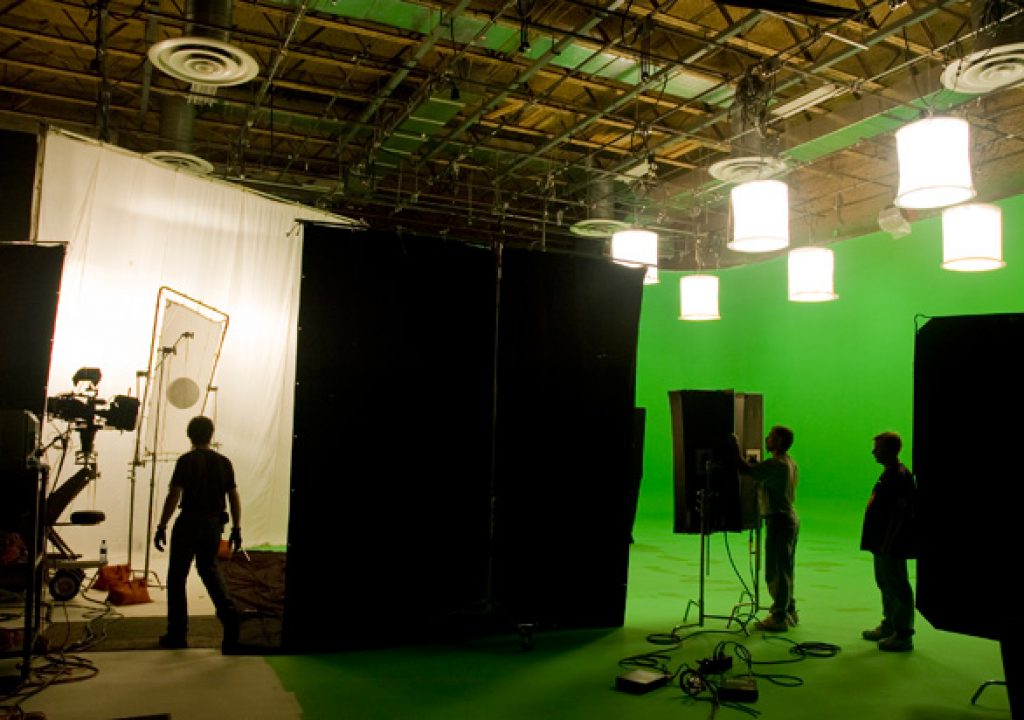
Not long ago a student asked me a question that on its surface seemed very simple: “How do DPs approach lighting a set?”
I’ve spent a fair bit of time dissecting the approaches of DPs I admire, and over time I’ve formulated my own method for walking onto a set for the first time and figuring out where to start. I thought I’d post a few ideas in return, and those few ideas called all their friends and asked them to participate.
Since an important aspect of lighting is convincing your crew to do it for you, here are some random bits of both lighting and management advice for aspiring cinematographers and videographers.
————————-
I try to follow the sources in the location, when possible. When I can’t follow the sources, I follow the story. A good story will tell you what it should look like, and by extension where the lights should go.
When you light a set, don’t ask yourself if it looks real. Ask if it is believable. There’s a difference.
When in doubt, backlight. When you can’t backlight, sidelight. When you have too much light, unlight. I use a lot of negative fill. If I can’t add light to create contrast, I’ll take it away.
Light the background first, if possible. You’ll always need a background to shoot against. People aren’t too hard to light once you know where they are.
Don’t worry too much about lighting people evenly as they move from place to place. You can create a feeling of three dimensionality if your subjects become brighter and darker as they move through a space. Just make sure they look good where they stop and deliver a line.
Sometimes the only place you can put a light is the right place.
Sometimes the right place to place a light is the opposite of where you normally would. I recently lit the background of a small set and then had to figure out where to put the lights for the single actress in the scene. The obvious answer was to hang them from above but that seemed too predictable so we put all her lights on the floor. The shot looked very cool, and not formulaic.
Don’t hang on to the “rules” too tightly. In film school they teach you that lighting someone from below is “horror lighting.” Trying putting a 4’x8′ bounce card under the lens and bouncing a light off it. To me it looks like sunlight reflecting off the floor on a summer day. Oooo, scary! Not. Sometimes the rules are outdated, or don’t apply to all kinds of light. Learn the rules, and then practice breaking them.
For me, lighting is all about layers. The background is one layer, the talent is another, the foreground a third, etc. The question I always ask myself is, “How can I separate this layer from that layer to create a sense of depth?” I recently shot a spot where a couple danced in the entryway of a house. The entryway was so small that I had nowhere to hide lights. I lit the dining room in the background instead and let them play against it in partial silhouette. It was beautiful.
The better a set is decorated the easier it is to light. There’s nothing worse than being stuck in a blank white-walled room with windows… except to not have windows. The eye goes to bright areas first so making your subject brighter than your background is usually a good thing… but not always.
When I first walk onto a set I usually stand there for a minute or two looking thoughtful and competent while I run all sorts of different scenarios. “What if I smack a hard light through that window? How do I avoid that boring white wall? What if I build a big soft source right over the camera?” I’ll play all sorts of crazy games in my head. Most of it revolves around how faces will catch the light (I’m all about making actors look good) and experience working in other locations. I’m also thinking about how malleable a setup is so that I’m not locking myself into shooting just one direction. I don’t want to spend a lot of time relighting each setup if I can avoid it. As a mentor once told me, “It’s not just about making pretty pictures. It’s about making sure the trains run on time.” It may be fun but it’s still a business. Fast lighting makes for a popular DP.
Another mentor once told me, “Every chance you have to make a decision, make it. If you’re right half the time you’re doing extremely well.” He was a very successful man. I paid attention. It works.
Occasionally I’m asked, “How often do you compromise?” I think every setup is a compromise to some degree because it rarely looks like I see it in my head. Occasionally it’s better, though, and it’s always an adventure. You’re playing “beat the clock” and you’re trusting your experience to steer you right.
It’s important to prioritize, and to know when good enough is good enough. If you spend two hours lighting a hallway shot where one character asks another for the time you’ve lost 85 minutes towards lighting the pivotal love scene later in the day. Know which shots are crucial and which ones are gravy, and act accordingly.
It’s imperative that you work with a gaffer you can trust and who has a good eye, who is on your side and isn’t competing with you. Trust them to learn what you like and turn them loose once in a while. It’s very important to let your crew contribute in their own areas, as long as you’re all on the same track. It’s not necessarily entirely up to you to have all the ideas; it’s usually better to have the key ideas and then manage the contributions of others. As a DP I was operating for once told me, “The more ideas you have the fewer I have to have.” That was a very confident DP.
It’s always a group effort. Take advantage of that, to your benefit.
Don’t let on if you’re not happy with a setup. Most likely the bosses won’t know that you’ve done anything less than stellar. Your eye is better than those you work for, which is why you’re working for them. If they’re happy, there’s no reason to let them know
you’re not. I once saw a gaffer say loudly to a DP, “This setup sucks! I hate it” The DP responded, “You only make yourself look bad by saying that.” That was a good lesson.
The most important things for an aspiring DP to remember are:
(1) Keep a good attitude, no matter what. Being pleasant will get you farther faster as a rookie DP than anything else. Always keep in mind that you could be flipping burgers or working in a cubicle for the next 30 years. Every day you shoot is a gift.
(2) Work as quickly as you can. Prioritize your shots and know when you need to work quickly on a throw-away shot in order to spend more time on a crucial sequence. Plan ahead. Do your homework. Have contingency plans for your contingency plans. This will seem like hard work at first but it gets easier with practice.
(3) Don’t beat your crew up unnecessarily. Some DPs think they only need to keep the director and producers happy but if you can keep your crew happy they’ll watch your back. If you cause your crew to do a lot of extra and unnecessary work, apologize profusely and they’ll continue to help you. Otherwise they’ll sit back and snigger when you screw up, and you’ll know they saw your mistake coming for the last hour.
You need your crew to make pretty pictures. Show gratitude for their efforts. You can’t do it all yourself.
(4) Know what kind of shoot you’re on. I shot a video game-style piece recently where we had to shoot 71 pages of dialogue-heavy script in four days, with occasional green screen shots. I focused on simple and fast, making the most out of whatever was at hand, because the director made it clear that the priority was just to get the material on tape. Some setups looked really, really nice and others were just fine. The important thing was to keep moving forward no matter what.
I go into every shoot intending to make it look phenomenal, but if the producer or director tell me that it’s more important that the trains run on time, I bring a train schedule and wear my finest conductor’s hat.
(5) It’s not about you. We’re in a service industry, and it’s crucial that we give our clients what they want. Hopefully you’ll be hired by clients who are excited by the work you do and give you a lot of freedom to create, but sometimes you’ll find yourself in a situation where you have to shoot in a style you don’t like. When that happens, revel in the craft instead of the art. If you can’t focus on good and fast, just focus on fast. You’ll make the bosses very happy. In a few days you’ll be on another job with another style anyway.
(6) Enjoy the people you work with. You’ll be spending a lot of time with them. A LOT of time. Be nice to everyone, especially the PAs. One of them may hire you someday.
(7) As a young camera assistant I was taught four cardinal rules: Show up early, punch in on time, do your job, keep your mouth shut. As a DP the “mouth shut” rule no longer applies but the other stuff still counts.
This article was originally posted to the Cinematography Mailing List and also appeared on my web site.

